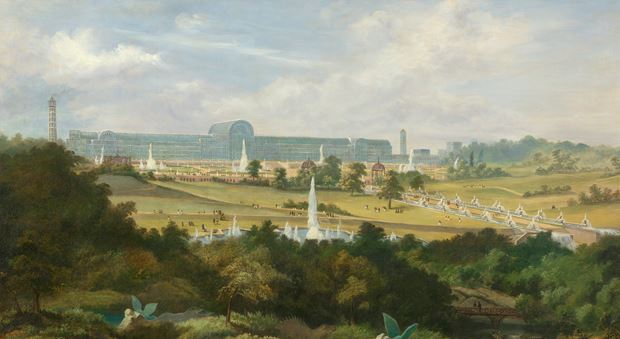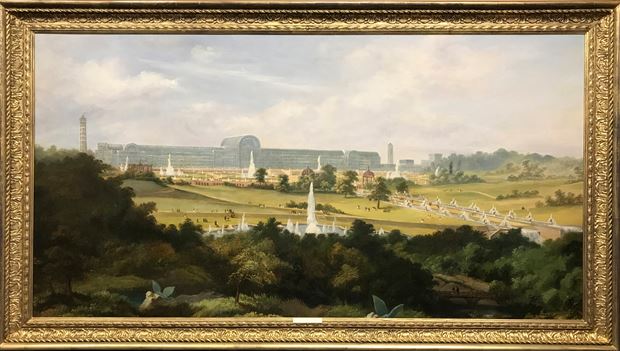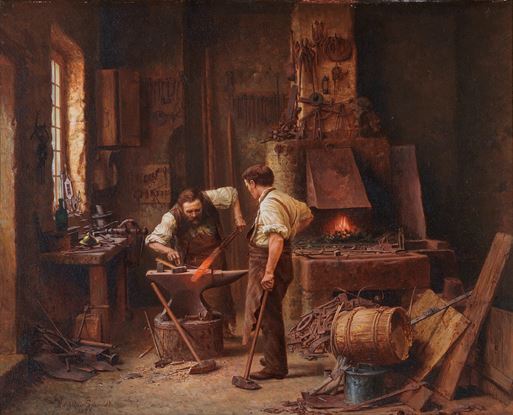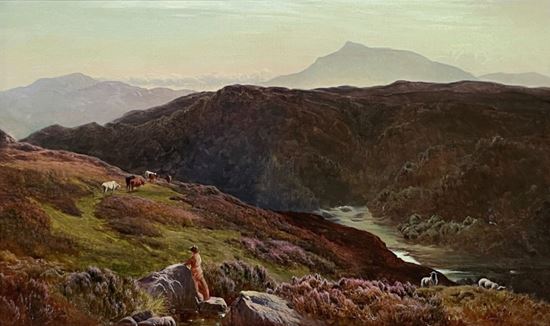Attributed to Edmund John Niemann
(1813 - 1876)
The Crystal Palace, and its grounds, Sydenham, London
circa 1860
Oil on canvas
41¼ x 75½ in – 104.8 x 191.8 cm
Frame size
50 x 84 in – 127 x 213.4 cm
Oil on canvas
41¼ x 75½ in – 104.8 x 191.8 cm
Frame size
50 x 84 in – 127 x 213.4 cm
Height 2 in (127 cm)
width 0 in (213.4 cm)
width 0 in (213.4 cm)
Tel.: +44 (0)20 7839 7693
Provenance
with Hazlitt, Gooden & Fox Ltd., London;
Private collection, UK
Private collection, UK
Revue de Paléobiologie, Michael E. Howgate: The missing models of Benjamin Waterhouse Hawkins, pub. Geneva, 2024, vol.43 (1), p.139-153
Biography
The son of a German, who had settled in London, Edmund Niemann’s career began at Lloyds. However, in 1839 he abandoned the world of insurance to become a professional painter, producing paintings of landscape, angling subjects and marine subjects. Niemann exhibited fairly regularly at the Royal Academy between 1844 and 1872, and at the British Institute between 1845 and 1867. He was one of the founder exhibitors at the “Free Exhibition” held in the Chinese Gallery, Hyde Park. In 1850 this became the Portland Gallery, Regent Street, of which he became Secretary.
Briefly at the beginning of his career, Niemann lived in Yorkshire and then in High Wycombe, before returning to London, where he lived in Pentonville and Hampstead before settling in Brixton in 1872. However, he continually returned to Yorkshire to paint and is particularly associated with the area around Richmond and Swaledale and the eastern coast. His paintings are often large and M. H. Grant in his “Dictionary of British Landscape Painters” says ‘Often a noble work which can only be described as a masterpiece.’ His son, Edward H. Niemann ( fl.1863- 1867) was also an artist who painted in a style similar to his father.
His works can be found in museums in: Birmingham; Glasgow; Leeds; Liverpool; London, Victoria and Albert Museum; Nottingham and Wolverhampton. His portrait, by E. H. Corbould, is in the Nottingham Gallery.
Briefly at the beginning of his career, Niemann lived in Yorkshire and then in High Wycombe, before returning to London, where he lived in Pentonville and Hampstead before settling in Brixton in 1872. However, he continually returned to Yorkshire to paint and is particularly associated with the area around Richmond and Swaledale and the eastern coast. His paintings are often large and M. H. Grant in his “Dictionary of British Landscape Painters” says ‘Often a noble work which can only be described as a masterpiece.’ His son, Edward H. Niemann ( fl.1863- 1867) was also an artist who painted in a style similar to his father.
His works can be found in museums in: Birmingham; Glasgow; Leeds; Liverpool; London, Victoria and Albert Museum; Nottingham and Wolverhampton. His portrait, by E. H. Corbould, is in the Nottingham Gallery.




_2732024T105329.108.jpg?width=550&height=415&format=jpg&qlt=80)